Scout pythons help scientists battle spread of giant snakes as program passes 10th year
A team of python biologists working for the Conservancy of Southwest Florida bounce along in a white four-door truck on a farm road well east of Naples.
Ian Bartoszek brings the Ford to a stop, grabs his telemetry gear and hops out of the carriage.
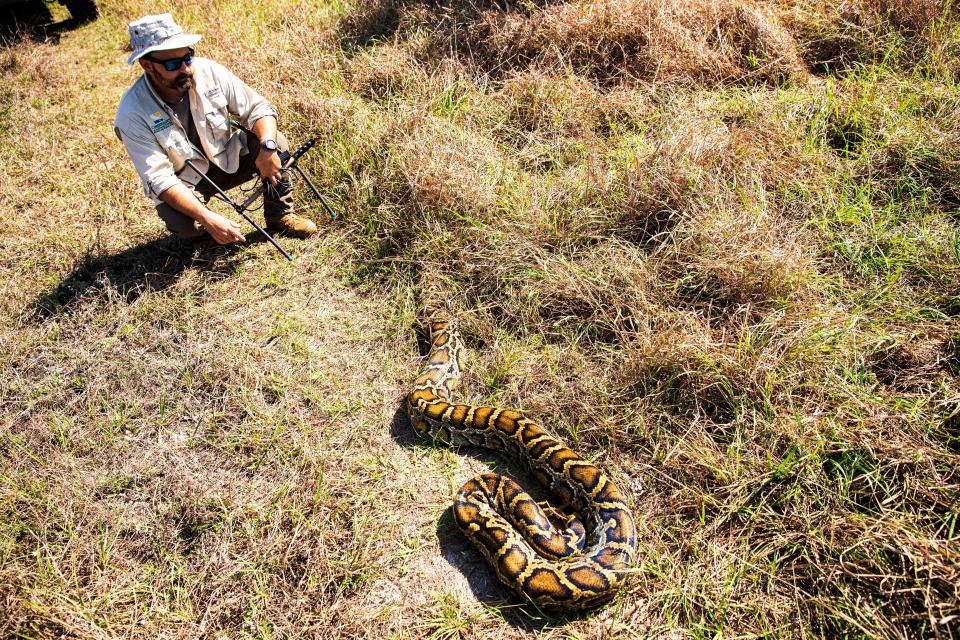
He holds up a giant antenna while faint beeps come from a handheld receiver. The chirps get stronger as he walks through a field with invasive grasses that create a thick canopy for invasive snakes like Steve, who was named after the late television wildlife enthusiast Steve Irwin.
"He might be showing off (and be easy to find), he might be in a hole in the ground — who knows," Bartoszek says. "This time of year, they're recharging and laying low until the water levels rise and they start feeding again."
Bartoszek is part of a decade-long Burmese python research and removal team that is starting to show results in the battle against the invasive apex predators.
Our best python photo galleries: Python Week: 10 amazing photo galleries of the snake invading Florida
Amazing python photos: 28 of the best Burmese python photos from our archives

He and fellow Conservancy biologist Ian Easterling are looking for Steve, one of about 40 male pythons, or scouts the Conservancy tracks and uses to lure breeding females.
Over the years, with the help of Easterling and interns, Bartoszek has built and led the premier Burmese python removal program when it comes to big snakes.
Not only are biologists at the Conservancy of Southwest Florida removing a lot of pythons from the wild, they're getting quality snakes, females that would have laid up to 100 eggs if not captured and removed from the wild.
Tips: How you can humanely kill a Burmese python and other big snake tips and pointers
Guts and gonads: Deadly Burmese pythons: Summer means it's time for biologists to crank out necropsies
Python hunt 2023: Fish and Wildlife Commission sets Burmese python hunt for 10 days in August; what we know
"We're trying to win the Super Bowl every year and we need to peak in the playoffs," Bartoszek says whiles driving through a farm. "There is a no-go zone. If we go a mile through mangroves, we will not burn the team out. If we go on a dumb mission, a drag-out we call it, we'll burn out or somebody will get an injury and that doesn't cut it. There's risk and reward and we will punt the ball if we get in marsh that's waist deep."
Burmese pythons have wreaked havoc on the Everglades system, killing and eating native wildlife and competing with others for food.
Bartoszek, with some help from Easterling and others, has developed a technique over the years where they release tagged males and then find them during breeding season, with the hope that they're with at least one female.
Myths addressed: What should you do if you're bitten by a venomous snake in Florida?
Danger: A look at the notorious cottonmouth and the lore that follows this common snake
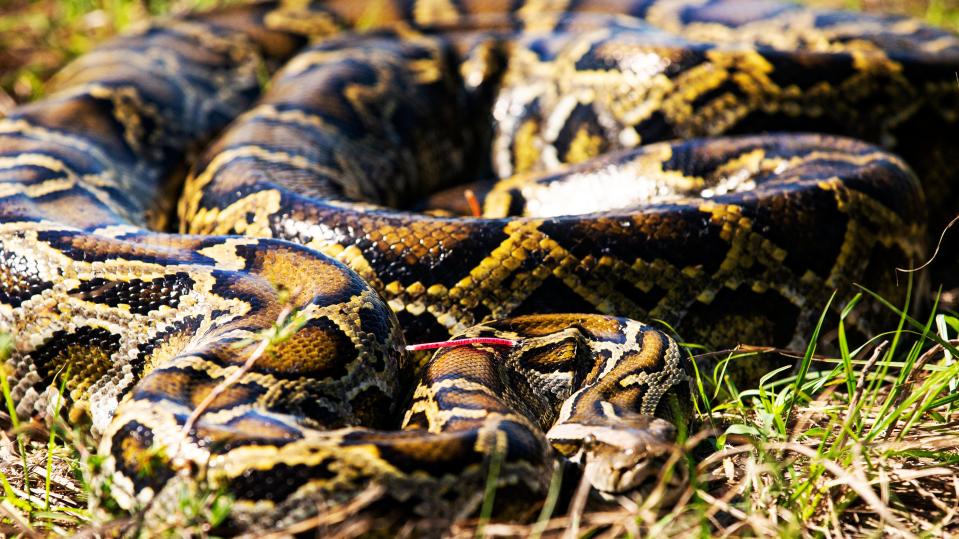
"We read the tea leaves," Bartoszek says. "We see what our animals are telling us and we adapt and maneuver every season. And that's why we've become successful at removal efforts. We're interested in what they're interested in, breeding females."
Today they're looking for Steve.
He's an ally in the battle against the pythons, a male that's proven in the past to attract females during the winter and spring breeding season.
Steve's resting spot is in an invasive grass patch on a remote farm east of Naples. The grass is so thick that you walk on top of it instead of your foot hitting the ground, which is a foot or more down.
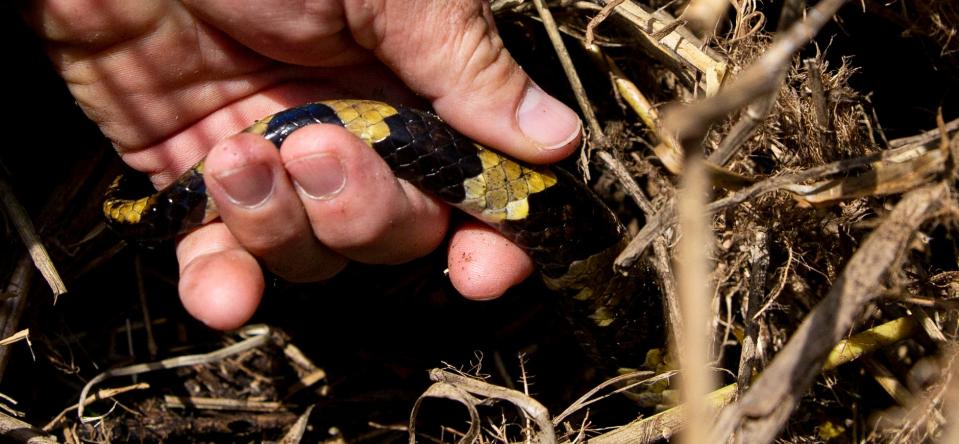
The program has produced the largest Burmese male python captured in the world, the largest female Burmese python in Florida, and has documented some as the furthest offshore.
"Hurricane Irma (2017) pushed them out of Everglades National Park and into the Gulf of Mexico," Bartoszek explains. "Stone crabbers were finding them coiled up around their crab trap buoys about 15 miles off Highland Beach."
The team has also documented one of the largest breeding aggregations in the world.
Releasing males back into the wild does come with certain consequences as the males must eat, too. But the ends justify the means as one male snake can lead biologists to several female snakes.
"And with the males, we don't see them getting large prey items,' Bartoszek says. "And one male can help us find five females each season. One of our best males, the one that found the 215-pound female, that was one of five females he found that season. That female had 122 developing follicles."
The number of potential snakes removed from the wild becomes exponentially higher as you pile generation on top of generation.
"If you take the average of 46 eggs and then you get the sense of those eggs that the male kept from potentially hatching," he explains, then "you can say hundreds of eggs that snake kept us from hatching that season alone. Does that justify what the male eats? One thousand percent."
They found one snake that was trying to eat more than its weight.
That 31-pound snake was found with a 35-pound fawn in its digestive tract.
Further east, near the edge of the 160-square-mile coverage area, Bartoszek and Easterling prepare to release George and Histopher, two adult males that were found together scouting for a female.
"These guys are going out for deployment," Bartoszek says while Histopher lives up to his name and hisses. "We caught both of these boys together with no female around. They met up with each other because they knew each other. We did not find a female. They met up and were just going ground (looking together for a mate)."
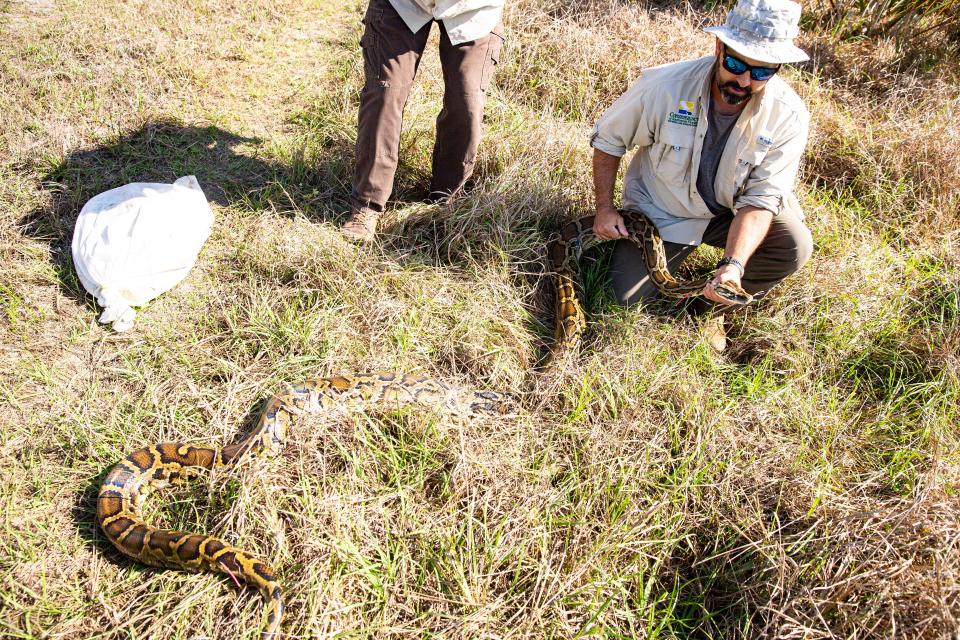
Both biologists say George is a little thin. Males are skinny this time of year because they spend the winter and most of the spring traveling to find prime females.
Some snakes here travel miles during a breeding season, from preserve to preserve and along the urban boundary that separates developed areas from farm lands and preserves, Conservancy research has found.
"There's a difference between being in prime condition to go find a mate and the end of the season when they're so tired," Easterling explains.
For the team, April is a transition month between the breeding season and the necropsy and data analysis season. They both roughly mimic the transition between dry and wet season here.
The hectic and time-consuming process catching snakes and the time of year when they can analyze data, check on their male snakes and perform valuable necropsies.
"He's running the urban edge here, and this is a total haystack," Bartoszek says. "How would you find the needle (a 30-pound python) at your feet? Forget it."
The snakes here have evolved to the point that they have different DNA from the snakes in their home range, which is one minor reason why the snakes can't be sent back to Southeast Asia.
Burmese pythons here also carry parasites that aren't found in their home range, and some of those parasites can be passed on to native snakes.
Spreading parasites to native species is just one way in which these behemoth snakes impact local wildlife.
They also eat untold numbers of at least 37 species of mammals and 27 types of birds.
Anecdotally, hunters and some wildlife enthusiasts have for years report seeing little in the way of small mammals in the historic Everglades system.
But it's not just the rabbits and raccoons that are suffering. Bobcats, panthers, and even alligators are on the menu.
On a recent lab day, Bartoszek and his crew pulled the hooves of a medium-sized whitetail deer from the bowels of a 12-footer.
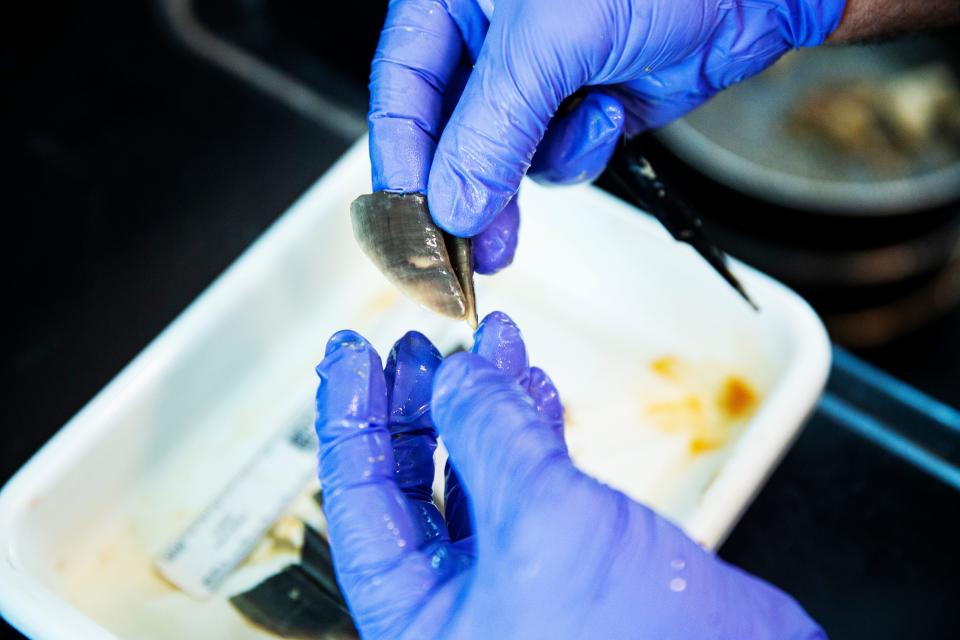
It's this type of work that puts the program at the peak of python suppression in Florida.
Other non-profits and some governments agencies have studied the problem over the decades, but the Conservancy is starting to prove that eradicating big females can at least control the density of snakes in particular areas.
"We say localized control, or attempting to suppress local population," Bartoszek says.
Connect with this reporter: Chad Gillis on Facebook.
This article originally appeared on Fort Myers News-Press: Massive female pythons targeted as innovative program passes 10 years

